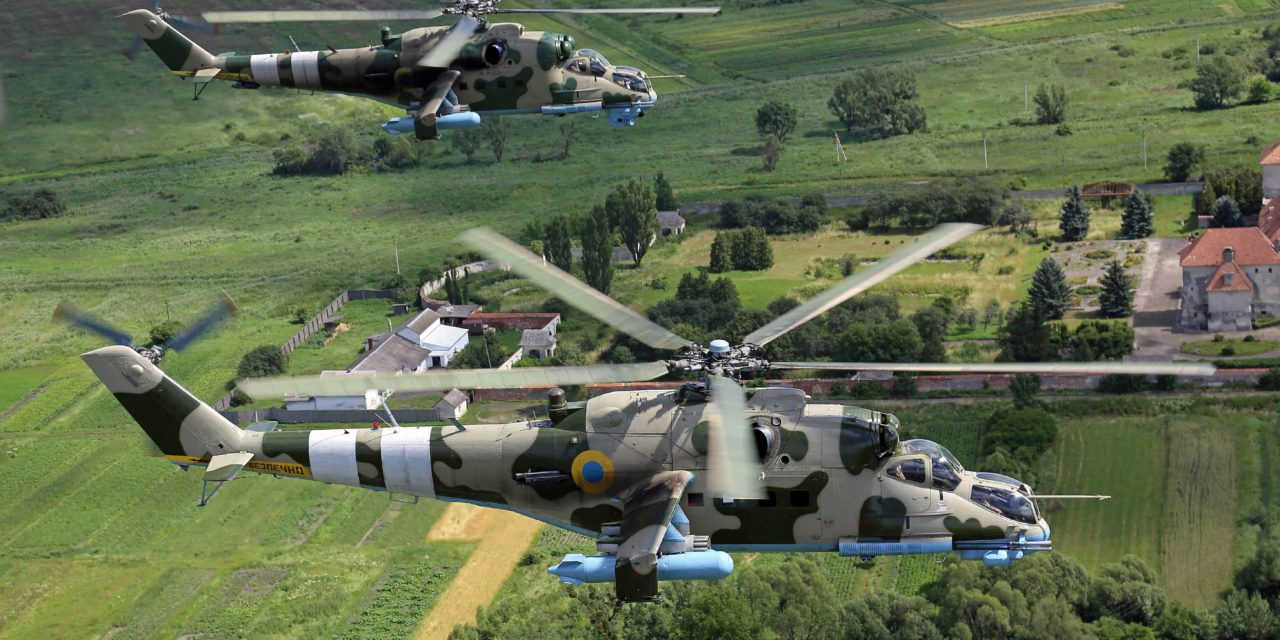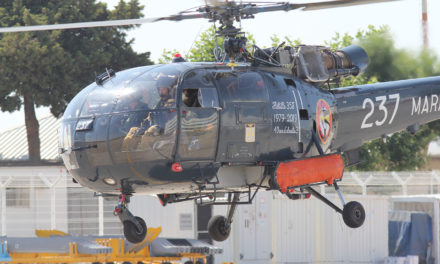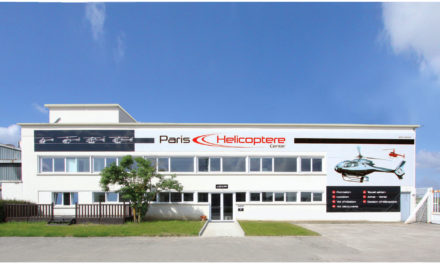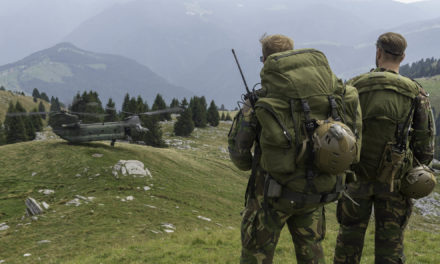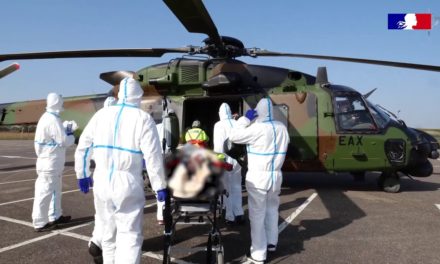During several visits at the 16th Independent Helicopter Brigade of Army Aviation in Brody (OBr AA) close to the city of Lviv, the 18th OBr AA at Poltava, the 12th OBr AA at Novy Kalyniv and the 11th OBr AA at Kherson the author got an impression about the current challenge of Ukrainian army aviators amongst two demanding tasks. Since years they cope with challenging duties of UN deployments in Africa. Furthermore, since beginning of ATO (Anti-Terrorist Operation) in 2014, they are required permanently in the east of the Ukraine and at the border line to the Crimea.
In Western Europe hardly recognized, the Ukrainian helicopters achieve tremendous successes in Africa. Painted in noticeable white colours and marked with the UN identifier they fulfil their duties for more than a decade. This applies also to the 16th Independent Helicopter Brigade, the “Fighting Bees” of Brody on the Ukrainian western border. They were already established in 1981 during Soviet times as the 119th Independent Helicopter Regiment. After the foundation of the Ukraine and the accompanying reorganisation of the armed forces, the unit carried the names 3rd Brigade respectively 3rd Regiment until 25th December 2012. Already with those names they participated in their first UN missions.
Multinational operation
The long list of deployments reaches from UN Protection Force (UNPROFOR) 1995-1996 via UN Confidence Restoration Operation (UNCRO) in Croatia 1995-1998 and KFOR in Kosovo 1999-2001 to the UN mission in Sierra-Leone (UNAMSIL) 2001-2005. Currently after the end of UNOCI they have to cope with two peacekeeping missions at the same time. At the moment all missions are taking place in Africa with the UN missions MONUSCO and UNMIL. Within these two missions the deployment in Liberia (UNMIL) is practically a permanent task that takes place since more than a decade. Reasons for the UN mission were the occurring civil war as well as the resignation of Liberia’s former president Charles Taylor in 2003. Initially, a peacekeeping force of the West African Economic Community ECOWAS together with a small contingent of United States Marines Corpse took over the responsibility to establish and secure peace. On 19th September 2003 the UN Security Council provided with resolution 1509 the legal basis to conduct a multinational mission. Main task until today is to allow refugees a secure return and disarm the different groups of rebels. With resolution 2116 from 18th September 2013 the UN Security Council prolonged the mandate. For the Ukraine the deployment in Liberia started on 11th January 2014 with a vanguard of 18 men. Those formed together with the following troops the 56th Independent Helicopter Detachment. The transfer of overhauled Mi-8 and Mi-24 helicopters as well as necessary spare engines took mainly place with An-124 cargo aircraft via the international airport close to the capital Monrovia. Additional cargo and troops found their way to Africa in Tu-154 or respectively on seaway. The relocation happened rapidly. End of January 2004 the planned contingent of 300 Ukrainian troops including functioning equipment was reached already.
Based in Congo
From the beginning the mission proved to be challenging for soldiers and material. Temperatures of +40 to +45 °C with a humidity of 90% to 98% have to be coped with. On top of that comes heavy rain for half of the year and the long distances. The strategically important Greenville is 230 km away and has to be approached regularly with Mi-8 for logistical tasks. The Mi-24 serves for reconnaissance and patrol flights. Even if the situation eases after the elections and foreign troops can be withdrawn, the Ukrainian helicopters probably will stay in until the end in smaller numbers. After five Ukraine helicopters in 2016, now there are three remaining. Close related to the mission in Liberia was the UNOCI operation in Cote de Ivory. The 56th Independent Helicopter Detachment from Liberia did sent the three Mi-24 helicopters to this African hotspot. The mission was ongoing until March 2015. The second UN-mission with participation of Ukrainian helicopter technology takes place in the Democratic Republic of Congo. MONUSCO, how the mission is called, is one of the largest peace creating missions of the United Nations. It started on 30th November 1999 with Resolution 1279 under the name of MONUC. Reason was the so called second Congo War, where troops of the government in Kabila faced several movements of rebels. In spite of the UN mission, which even was extended to a robust mandate with active usage of weapons, and several years of relative peace, rebels took the provincial capital of Goma with one million citizens in 2012. From this point on, the Ukrainian helicopters can be found in Congo. They form the 18th Independent Helicopter Detachment. Main tasks of the of Ukrainian troops are air recce, transport of cargo, UN troops and VIP as well as show of force.
More than 50,000 flight hours
Especially in Congo the high amount of flight hours are big challenges for soldiers and equipment. All maintenance checks in 6, 12 and 24 month cycles have to be done in Congo. Extra hours occur frequently to manage all existing tasks. Taking the numbers of all deployments in Africa combined, it adds to more than 50.000 flight hours and more than 200.000 passengers for the Ukrainian Army Aviators since 2004. At the moment the following helicopters are based in Congo; four Ukraine Mi-8 and four Mi-24. The deployments in Africa were the main task for Ukrainian Army Aviators over years. However, the situation quickly changed in 2014 with the beginning of the Anti Terror Operation (ATO) in the east of the Ukraine in 2014. According to Colonel Igor Jaremenko, the Brigade in Brody misses the soldiers and helicopters that are sent to Africa immensely. Colonel Igor Jaremenko, who also gathered flight experience in Germany during his five-year assignment in Parchim, was in the beginning of the ATO in charge of the Fighting Bees at Brody and from 3.July 2017 he is now the new Commander of Army Aviation in Ukraine. Yet, a withdrawal of the troops deployed in Africa is not possible. The long-term contracts with the United Nations allow a withdrawal only in cases of catastrophe or war in Ukraine/home country. In generally used linguistic terms the deployment in East Ukraine still is a mission against terrorists, which is according to the contracts no reason to return troops. Volunteers helped to ease the situation. Nowadays, mainly patriots from Dnepropetrovsk (now renamed to Dnipro city) helped out at the Regiment. Since March 2015 the Ukrainian Army Aviators did not lose any helicopter during hot missions. Luckily, the initiated peace process of Minsk continues.
Five metres from the ground….
The casualties of the 16th Brigade in the scope of ATO are six helicopters (3x Mi-8 and 3x Mi-24) as well as eight crewmembers according to Colonel Jaremenko. Although the helicopter pilots own vast experience through their deployments in Africa, they still lost more than ten helicopters. The air defence system in Donbas is well constructed and strong. For helicopters as well as for Sukhoi fighters jets. This means: low flying provides security. Mayor General Valentin Pistryuga, former head of the Ukrainian Army Aviators, underlined during the beginning of the ATO this mantra and did even go one step further. During an interview he postulated that the tasks of Army Aviation have changed immensely with the introduction of manpads in Russia between 2012 and 2013. They also were used in the ATO zone rapidly. For Ukrainian pilots remained only one solution: –low-flying– five meters above ground is standard in the meantime. Through the deployments in Africa the pilots thankfully have on average more than 1000 flight hours. During the beginning of ATO the helicopters flew their support missions based on standard musters. Quickly, this approach changed. Timing became the most important factor of tactic. A helicopter circling over a convoy would easily reveal its presence. Waiting in secure distance and attacking in due time only proved to be a better approach. According to Mayor General Valentin Pistryuga the deployment of Army Aviation started during the first days of ATO already. Besides of transport of ammunition, troops and weapons the helicopters helped to evacuate wounded out of the warzone. Over 8.000 missions were flown until the Minsk-2 treaty. Especially at the beginning of ATO the crews had to work almost around the clock. From four o’clock in the morning until midnight the helicopters were in charge. Six missions a day per crew was not unusual. The typically psychological stress also needs to be taken into consideration. Small groups of enemies, equipped with Manpads, were able to move their locations quickly and even operate behind the frontline. High attention was necessary always. Sometimes even above the areas controlled by own forces they had to fly with the same precaution like in warzone. Of course there were casualties. However, the Major General Pistryuga is proud that all of them happened through missile attacks. In spite the high amount of low flying, there was not a single accident caused by the pilots. Along with the change of tactic the headquarters in Kyiv tries to improve the used technic. Modernization of existing equipment and machines is the choice of doing so.
Double-calibre flare system
With the Mi-24PU1 and the Mi-8MSB-V (Мі-8МСБ-В) there are already two modernized machines in progress. The Mi-24PU1 is based on the Mi-24P version, the main attack helicopter of the Ukrainian Army Aviation. It has one GSh-30-2 30mm two-barrel canon fixed to the starboard side and was delivered within the years 1981 to 1989. Besides them there are still a few Mi-24VP and some Mi-24RXP in Ukraine. The new PU1 model distinguishes through the usage of the modified engines TV3-117VMA-SMB1V-02 (TB3-117BMA-СБМ1В-02) and the installation of the ADROS KT-01AV self-protection system against approaching infrared missiles as well as the FPM-01KV laser searcher. Additionally, there is a Garmin navigation system GPS MAP-695 and the improved radio KY196V in the cockpit. Through usage of the new helmets THL-5NV with integrated night vision devices PNL-3, the Mi-24 is furthermore able to fly at night. The first Mi-24PU1 was delivered to the armed forces of the Ukraine in 2012. In June 2014 already three helicopters of this model, developed in Konotop at the Aviakon factory, were available. The Army aviators got also already several Mi-8MSB-V from the factory Motor Sich (Мотор Сич) in Zaporizhzhia. It is also equipped with improved modified engines. They are called TV3-11VMA-SBM-1V-4E (ТВ3-117ВМА СБМ 1В 4Е) and contribute enormously to the fact that the modernized Mi-8 performs excellent in altitudes above 2.000 meters or during extremely high or low outside temperatures. Motor-Sich even accomplished to create a new world record of a flight altitude of 9.150 meters with a Mi-8MSB-V in August 2014. The test pilots only needed 29 minutes and 30 seconds for this record. The modernized Mi-8 from Zaporizhzhia contains like most of the now used Army helicopters the “Adros” KUB 26-50 double-caliber flare dispenser system. This new Ukraine system is a more effective flare dispenser with larger bullets from calibre 50 mm in addition to the 26 mm flares. It can be used on different aircrafts and helicopters.
A legacy of the former USSR
The main part of the Army helicopters already have in use the new Adros KT-01 AVE Infra-red counter-measure system. It protects the helicopters against defeat by guided missiles with infrared (IR) homing heads. The passive system is jamming in 360° instantaneous and simultaneous with amplitude-phase, frequency-phase and time-pulse modulation. The introduction of the Mi-8MSB-V into the forces was however quicker than of the Mi-24PU1. As early as the end of 2014 the armed forces as well as the National Guard got machines. Helicopters for the modernization are more than enough in Ukraine. Originally, they had about seven combat helicopter regiments stationed within the Ukrainian territory. From 1991 at least one more was relocated to Ukraine due to the withdrawal from Western Europe. Correspondingly, it was not that hard to establish a new Task Force in February 2015. The new build 18th Independent Helicopter Brigade in Poltava got is first Mi-8MSB-V helicopter on 1.October 2015 and helps now to be well prepared in case the conflict in Eastern Ukraine intensifies again. It is the only unit using also Mi-2 for pilot training and liaison/transport missions. Not far away from a zone with high conflict potential is the 11th Independent Helicopter Brigade in Kherson. Also this unit has its history in the soviet time. It was formed beginning of the 1960is as 370. independent helicopter squadron. The Mi-6 using unit got 1972 as 320 helicopter regiment the status of a regiment. With the reformation of the structures and after the independence of the Ukraine it got in March 1992 the name 2. Army Aviation Brigade. The now called 11th Independent Helicopter Brigade received its final name 2012 and operates today Mi-8, Mi-24P and Mi-24PU1. The city Kherson is located not far away from the Crimea and in practise is the last Ukraine city on the way to the Crimea. Because of this the 11th Independent Helicopter Brigade is not only active at the ATO but operates also in the border region to the Crimea.
Text : Alexander Golz
Images : Ralph Blok (DutchAviationPhoto.com) – Alexander Golz

